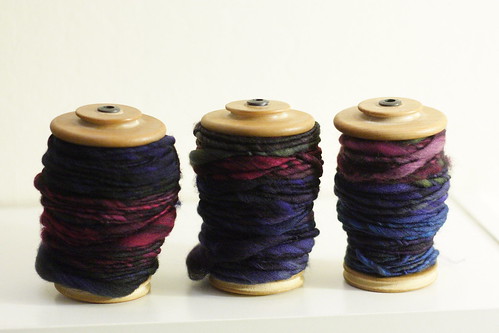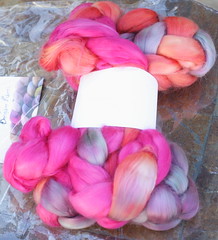Yarns in Progress- Targhee and milk protein supercoils
I hosted spinning at my house for the first time on Saturday! Thanks for the company and goodies, everybody! Bryan ate some of the lemon cake Lori brought when I was at work on Sunday, and he said Rocky knocked the package off the coffee table to try to get some. My cat is a lemon cake fiend! Bryan also says he wants me to host more often so we'll keep the house clean.
In the first 2 hours(!), I spun up 4oz of this Targhee roving in the Twilight colorway from Abstract Fiber that I bought at Stitches this year. Here's the thick and thin bulky singles I ended up with. Apologies for the quick-and-dirty indoor photo.

Then I started work on this milk protein fiber from fellow Phat Fiber contributor Patricia of Beesybee.

I crammed all 4 oz of singles onto this bobbin-

I decided not to worry too much about what the finished yarn is going to be and just spin the singles consistently at the width that seemed most natural. I considered a 2 ply, but I think I'll probably try a supercoil first! I want to preserve the separation of colors, but I don't want to knit something from the singles. I think I may want to wear the supercoil yarn as a necklace.
Last post, I mentioned I was confused about how much twist to put in the singles for supercoil yarns. A Spin-Off article by Jacey Boggs from Winter 2009 said you want it pretty overspun to give yourself a better chance at accomplishing all the plying steps without adding too much plying twist. This makes sense to me. That article talked about using handspun "high-twist laceweight singles" or millspun laceweight as the core and didn't use any method to take plying twist out of the core. It seems to me that there would be a pretty big difference in result based on whether a high twist singles or millspun balanced yarn were used for the core. It all makes more sense to me if the core is high twist too. I like how Jacey's yarns use an attractive core and let it show, especially to anchor the floofy parts. All of the yarns shown in the article use a thick-and-thin singles. That's what I tried with my first attempt, and that's what I want to do with the Targhee. I have some laceweight silk singles that I may dye to go with it.
The Spin-Off article from Spring 2008 that describes Sarah Anderson's wrap and roll method said you wanted the singles to be lightly twisted. The yarns pictured in it have a core made of crochet cotton that is completely covered by the singles yarn. There is no anchoring of wraps. The singles are more even and thinner. I like this look as well, and that's what the milk fiber yarn will be more similar to.
Both methods claimed to result in an approximately balanced yarn. I have not seen a satisfactory explanation of how this physically occurs. In my typical understanding of balance, you want the individual fibers to run along the axis of the yarn. For a supercoil, the singles would have to have an extreme amount of twist- basically horizontal. I think that would be a very harsh yarn.
I'll probably do a little more reading, watching, and sampling. If I need a little more or less twist in my singles, I can run them through the wheel again.
videos of wrap and roll method-
video 1
video 2
ps- I started the pillow panel from the crazy Crafty Scientist batt yarn today and it looks great! I'll try to get photos tomorrow in between trying out possible booth setups for Sunday. I'm halfway done if I want a 14" pillow.
In the first 2 hours(!), I spun up 4oz of this Targhee roving in the Twilight colorway from Abstract Fiber that I bought at Stitches this year. Here's the thick and thin bulky singles I ended up with. Apologies for the quick-and-dirty indoor photo.

Then I started work on this milk protein fiber from fellow Phat Fiber contributor Patricia of Beesybee.

I crammed all 4 oz of singles onto this bobbin-

I decided not to worry too much about what the finished yarn is going to be and just spin the singles consistently at the width that seemed most natural. I considered a 2 ply, but I think I'll probably try a supercoil first! I want to preserve the separation of colors, but I don't want to knit something from the singles. I think I may want to wear the supercoil yarn as a necklace.
Last post, I mentioned I was confused about how much twist to put in the singles for supercoil yarns. A Spin-Off article by Jacey Boggs from Winter 2009 said you want it pretty overspun to give yourself a better chance at accomplishing all the plying steps without adding too much plying twist. This makes sense to me. That article talked about using handspun "high-twist laceweight singles" or millspun laceweight as the core and didn't use any method to take plying twist out of the core. It seems to me that there would be a pretty big difference in result based on whether a high twist singles or millspun balanced yarn were used for the core. It all makes more sense to me if the core is high twist too. I like how Jacey's yarns use an attractive core and let it show, especially to anchor the floofy parts. All of the yarns shown in the article use a thick-and-thin singles. That's what I tried with my first attempt, and that's what I want to do with the Targhee. I have some laceweight silk singles that I may dye to go with it.
The Spin-Off article from Spring 2008 that describes Sarah Anderson's wrap and roll method said you wanted the singles to be lightly twisted. The yarns pictured in it have a core made of crochet cotton that is completely covered by the singles yarn. There is no anchoring of wraps. The singles are more even and thinner. I like this look as well, and that's what the milk fiber yarn will be more similar to.
Both methods claimed to result in an approximately balanced yarn. I have not seen a satisfactory explanation of how this physically occurs. In my typical understanding of balance, you want the individual fibers to run along the axis of the yarn. For a supercoil, the singles would have to have an extreme amount of twist- basically horizontal. I think that would be a very harsh yarn.
I'll probably do a little more reading, watching, and sampling. If I need a little more or less twist in my singles, I can run them through the wheel again.
videos of wrap and roll method-
video 1
video 2
ps- I started the pillow panel from the crazy Crafty Scientist batt yarn today and it looks great! I'll try to get photos tomorrow in between trying out possible booth setups for Sunday. I'm halfway done if I want a 14" pillow.



Comments